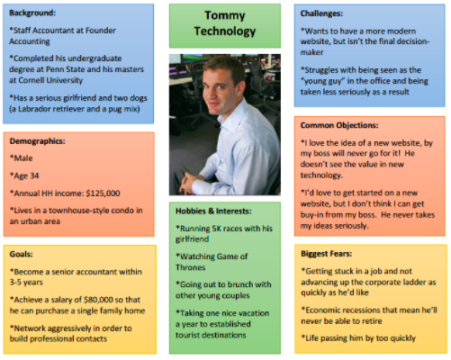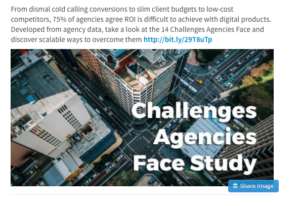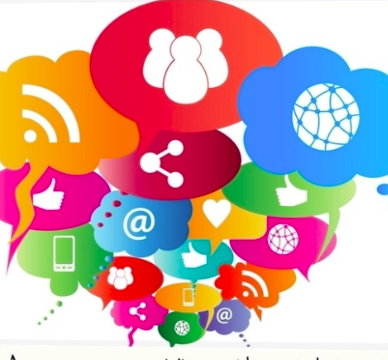How business and IT executives decide to make B2B purchases of technology platforms involves multiple people and stages. There are always invisible influences that make it difficult to understand what customers are paying attention to at which stage of the purchase funnel. This report looks at five research studies that answer these questions:
- What information purchasers use to stay “up-to-date”
- Who is involved in making decisions
- How they use your website
- What are the most influential types of content
- What purchasers want from technology sales executives
- Qualitative factors purchasers use to decide
- Top obstacles that prevent a sale
- Why companies decide buy from one company versus another
How key executives ‘keep up’ with options in the discovery phase
Key executives in a variety of roles – both on the business side and IT – need to keep up-to-date on technology that can transform aspects of their company.
The latest IDG survey of IT purchasers (September, 2016) shows that executives use more than ten sources of information in the discovery phase, however five most used information sources used to “keep up” are:
- Independent news and reviews (66%)
- White papers (58)
- Webinars (58%)
- Newsletters (47%)
- Technology vendor websites (48%).
The top source for most is actually colleagues and peers – a net 73%. Most used peers outside the company – by phone, email and in-person – at this stage as a source of information. However the most trusted sources are reading first source materials. The role of trade journals continues to be important.
40% also said trade show attendance are part of the mix.
Another net 73% of those surveyed said they some form vendor information and content that helped them keep on on industry trends. That’s the good news.
However, at this stage, passively looking at content (56%) is relied on as a source of information. This report shows that the sales person is responsible for 44%..
The Walker Sands study of the “pre-search phase” for purchasers of marketing technology said the sales executive is even less significant in discovery, only (5%) said a sales rep help them to instigate a search.
In the Walker Sands study, peer recommendations also tied for first, followed by online reviews (44%) and analyst reports (33%).
Print trade magazines (24%,IDG) were not used by more than 75% of purchasers. They are clearly getting their information online.
Software companies social media is also not the best way to reach new customers (29%, IDG). Walker Sands confirms that only 7% of buyers said social media influenced them at any stage of the sale and more than half said it had no influence at all, in spite of its use by 72% of tech marketers.
Who is involved in making the purchase
The decision-making process involves a mix of people from the business side, the IT side and “colleagues” whose departments will be affected.
Corporate buyers have different processes. In some companies the decision-making is more centralised, in other it’s more distributed.
A 2015 recently-released study from SiriusDecisions shows one way to look at three types of corporate buyers: Independent, Consensus and Committee. We advocate creating a customer persona for each of these groups your company sells to.
Independent
These are smaller corporations in the Owned and Operated (O&O) category, who may buy in less than 8 weeks, for platform <$50,000 and include 2 to 4 people in the decision loop, including 1 to 2 buying centers and 1 to 2 colleagues.
Consensus
These sales take place over a longer time period – 1 to 2 quarters – and involve a technology purchase of $50,000 to $500,000.
The decision- making for this style takes place across “teams functions or departments” so more buyers and colleagues were involved, 3 to 4 buying centers, with 3 to 5 colleagues who may be attending product demos.
The number of interactions with the vendor also increased to 14, with 8 human and 6 non-human interactions.
The majority of respondents in this category said sales exectuives helped inform their decision at every stage.
Committee
These are the largest sales, starting at $500,000 and running into the millions. They require 1-2 quarters or more to make a decision, have 5 or more buying centers plus 6 to 10 colleagues who are also involved. There many be 9 or more human and 8 non human interactions. The sales representative was also more important as a source of information at every stage.
We have seen verticals vary from this model, with sales under $50,000 still requiring 3 to 5 buying centers, ten to 20 total employes, and taking 2 quarters or more.
But in general the larger the sale:
- The larger the number influencers
- The longer the sales cycle
- The more human and non-human content-oriented interactions
In general, however, expect to appeal to many people within the company whose opinions count, even if they are not voiced to the sales representative.
The role of peers as a source of information is critical
Peers inside and outside the company, remain information sources in all stages of the sale. Companies are talking internally about new platforms and listening to what others around the company have to say.
Here’s where peers rank in five (1 is high) most used sources of information at each stage of the buying cycle, from “Keeping up to date” to “making a purchase” :
Keep up to-date – Peers outside the company, 4
Determine business need – Peers inside, 1 to 3 peers outside the company, 3
Evaluate products – Peers inside the company, 3
Recommend and select vendors – Peers Inside and outside, 3
Sell internally – Peers inside the company, 1
Make a purchase – Peers inside the company, 1
Notice how information from peers is always used in the final stages of the sale. Later in this report, data shows what they are talking about: Ease of use, difficulty of implementation, and price. The sales person who appears as highly important during the research phase will drop out at the end when these conversations are occurring.
What purchasers want from sales people
As we noted, few companies said that sales executive gave them information that instigated a search (5%, Walker Sands), although this make underestimate the role of salespeople interacting with influencers (peers) at trade conferences and other groups.
But that changes radically as key executive begins researching a solution, and the role of the sales person becomes critical.
IDG’s 2016 survey of IT Purchasers (both hardware and software) shows that purchasers said want a lot from sales reps:
Speedy answers(67%).
Free trials and test drives (64%).
Advice and best practices (52%).
Case studies (50%)
Educational assets and references (46%).
Ask them questions and show ROI (30%)
They dislike direct sales pitches.
Note that four of the kinds of information wanted by more than half of all purchasers include these top types:
- Free trials and test drives
- Relevant information delivered on a timely basis,
- Advice/best practices
- Case studies
A conclusion from this data is that as the purchase cycle moves from research to product demos and onward, two or more purchasing decision-makers need to answer questions “bubbling up” – or down – from colleagues and bosses, and want speedy answers from reps.
Having the top resources available to send in an instant – and an expert who instantly reachable by phone is a best practice.
The sales rep was also included as one of the five top sources of information (with 1 being the most used) at every stage after a search began:
Determine need – 4, in-person along with trade conferences
Determine technical requirements – 3
Evaluate products and services – 2
Recommend and select vendors – 1
Sell internally – 3
Make a purchase – 3, by phone, email
At the “make a purchase phase” a key factor for IT managers is “customer experience” – and this really means how the sales department is responding.
The role of vendor website and content
Research from Hinge Marketing concluded that 81% of companies in in B2B purchased have researched the vendor website. The quality of a website was also a reason given for excluding a company as an option.
Walker Sands show a similar result: Purchasers of marketing technology said that during the research phase they were equally influenced by Website (29%) and Vendor content (29%) just a point behind Independent reviews (30%). Put the content prospect need to differentiate your platform, plus case studies and reviews that prove the value proposition on the the website!
A final data point on the importance of websites: The company website is was as important as the product demo for CMO’s and had some influence for about 9 out of 10 buyers.
Below is where the website is one of top five information sources (with 1 being high) for purchasers along the cycle:
Keeping up to date – 5
Determine business need
Determine technical requirements – 3
Evaluate products and services – 1, ahead of sales rep
Recommend vendors – 5
Sell internally
Approve, authorise purchase
So prospects are not only looking at website to line up possible vendors, they are also actively using it to evaluate products and services.
So what kinds of information should be available on the website, besides the list of products and services?
Studies show that executives said they were most influenced to make a purchase by the Product Demos (52%) and Case studies/testimonials (47%) (Walker Sands).
In fact case studies/testimonials were the most important factor for VP/Directors and Coordinators, followed by the product demos. The reverse was true at the C-level.
So while “white papers” are used to “keep up to date” in the pre-search phase, the website should also include easy paths to sign up for a product demo, and use case studies that prove ROI, or other key benefits.
Incidently, Videos (15%) and webinars (14%) are further down the list of what was most “influenitial.”
Only 7% saw social media as influential and almost half said social media had no influence at all on their decision. Marketing Charts, which also conducts research also found this in MarketingCharts’ B2B Digital Marketing Insights Report found the same thing.
Why companies decide to make a purchase
In the IDG survey, companies met with 3 to 5 vendors and spent nearly three hours meeting with them. So how do they make a decision between companies, or whether to make a decision to purchase at all?
At the decision-making phase price and ease of use were cited as the most important factors for buying marketing technology, (Walker Sands).
Price was the most important factor in the decision for CMO’s. For VP/directors and other employees ease of use was the most important consideration in deciding to buy.
IDG survey also showed that IT executives place the greatest value on customer experience, with two-thirds rating it as the most important element of a quality relationship.
Business managers differ somewhat, favoring helpful answers to questions.
What prevents companies from making a purchase
Companies cited budgets, difficulty of implementation and internal resistance as the largest obstacles to buying marketing technology (Walker Sands).
This is why colleague and peers are so important, including the opinions of non-C level employees, do in fact count ( MarketingCharts).
However, the influence sales person drops off at this stage – In other words, the company is now discussing options internally, based on the information they already have.
The lesson to be learned here, is that answers to anticipated objections such as price and difficulty of implementation should be built into earlier stages, including the important content: Case studies and product demos.
It is also critical to find a budget – even if it is coming from another source, and if the money will come strictly from ROI to have those case studies to back it up.
Matching marketing to how purchasers buy
So are tech marketers matching their investments to these needs? An older study is the 2015, Regalix survey of 640 senior marketing executives and business leaders about their product marketing practices. The group included a range of B2B technology companies (software, hardware, cloud computing, and mobile). More than half were already using blogs, social media and paid search and online display ads.
Technology companies investing their websites, case studies, demos, webinars and email are doing this right. The stand-out observation here again is that 76% used social media that rarely influences IT buys at all.
In the introductory or growth phases of the company, video, events, and presentations were most important. In mature companies, case studies and blogs gained a central role. In-person events are important across the board.
As companies when into decline, the priorities shifted again, backing off of marketing overall.
Conclusion
So what are the takeaways from these insights for marketers of technology companies? First, begin with the end in mind, technology companies should be creating the right kinds of content that purchasers want at each stage of the marketing cycle, and have these materials on their website and available to the sales executives.
Here are a few takeaways and “best practices” based on this research
- Pre-research and part of the initial search and research is going on without your sales representatives.
They are keeping up to date with information from peers, publication of content in trade journals, peer recommendations, white papers and newsletters. The content plan should include these, along with a public relations strategy to stay in the more important online journals, or use of native content in trusted sourves.
- Have an impressive product demo.
Rather than just showcasing the technology, tell a story and make sure that everyone’s questions are answered. Build “ease of use and implementation” and pricing issues into the “story.” Demos should be flexible enough to respond to the client and the more people from within the company who see the demo, the better.
- Develop case studies/testimonials and best practices
More than half executives wanted case studies, references and best practices from sales people, and the most influential content was case studies/testimonials.
- The company website will be used in competitive research.
One of the surprises of the research is how much the website is used by buyers. Rather than being just a static brochure, it can help differentiate your company, showcase products and services described, and make case studies and testimonials available.
- Plan to capture email lists deeper into companies.
The importance of peer input at every stage, and of internal resistance as an obstacle, was also a key takeaway from these reports. More people are influencing the sale, even if they are not decision centers.
- Address price and find budgets early on
Assume your platform is being “price shopped” with three to five other companies, and that budget may prevent any sales from happening. The time to “find a budget” is before the decision “goes upstairs” where budget are a key concern. Us specific percentage increases in revenues, reductions in employees from real clients.
- The role of the sales executive is educational and representational of customer service.
Purchasers want to be in the drivers’ seat. The most interest prospects have started research and they want information quickly. Product demos should be customized and allow executives “drive” by asking questions.
The sale is made when the buyer understands not only how the problem will be solved, but also:
- Why the price makes sense
- Where the budget will come from
- How the implementation will work
- That peers agree on the purchase
- That Internal constituencies will like using the platform
- What other companies have had success
Information sources
- IDG Survey of IT Purchasers, September 2016 (IDG). This is a directly related study across IT industry including hardware and software.
- Walker Sands study, which surveyed 313 U.S. corporations in 2016 to find how they made a decision to purchase a marketing technology platforms.
- Marketing Charts – They provide a variety of surveys on B2B purchasers. (MC)
- 2015, Regalix survey of 640 senior marketing executives and business leaders about their product marketing practices from a range of B2B technology companies (software, hardware, cloud computing, and mobile).
A 2015 recently-released study from SiriusDecisions (Sirius)



 [
[


 1999 – Hewlett-Packard’s employees refer to a project using its own products as “Project
1999 – Hewlett-Packard’s employees refer to a project using its own products as “Project 












